27-28 September 2022
We arrive late to the Asia Hotel, our lodging for the next two nights. Traffic and narrow surface roads are challenging, or as our guide says: “Samarqand is very special for the traffic.” Our hotel is located in historic Old Town and just a few minutes’ walk from the Registan. My kind of place. It is International Tourism Day and we are welcomed with refreshments, all non-alcoholic.
Samarqand, or ancient Afrosiab, was founded between the 8th and 7th century BC. (I will use the spelling Samarqand as that is how the city spells it on their welcome signs.) It is one of the oldest continuously inhabited cities of Central Asia, which is saying a lot about ancient. Its longevity and prosperity came from its location along the Silk Road. Samarqand was conquered by Alexander the Great in 329 BC and ruled by a long succession of Iranian and Turkic Mongol rulers until the arrival of Genghis Kahn who reconquered the city in 1220. Temur stormed the scene and established Samarqand his capital in 1370. The culture and history of Samarqand and Central Asia was forever changed.
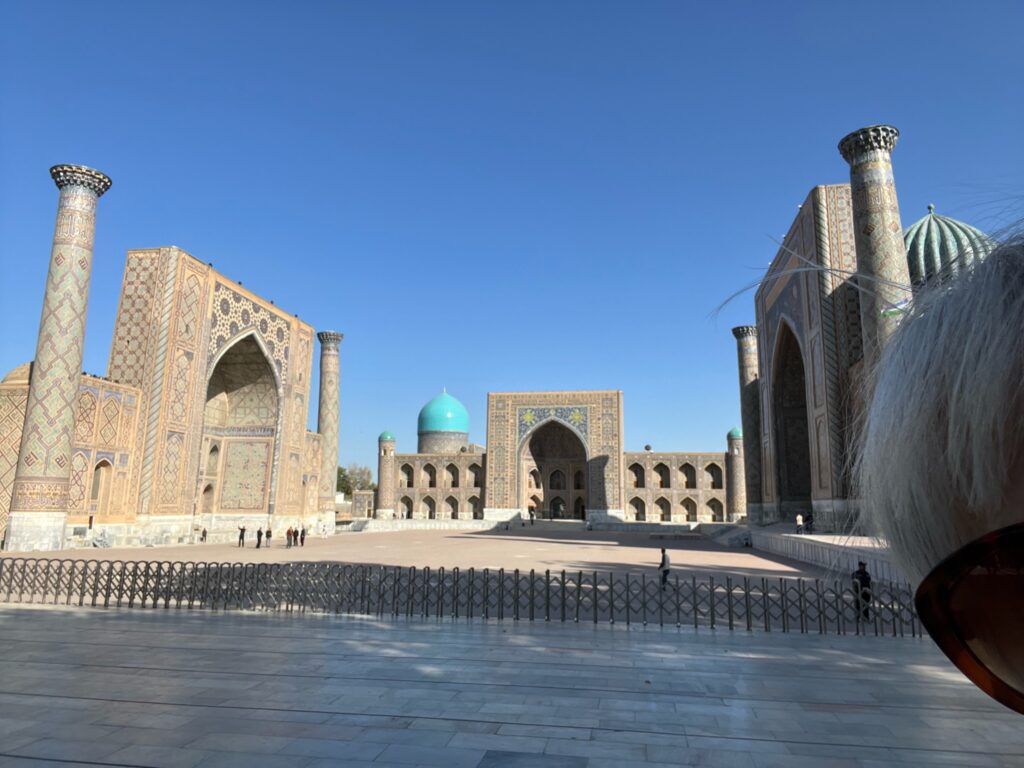
It is fitting that our first visit this fine day is to the heart of historic Samarqand – the Registan – a huge public square surrounded on three sides by madrassas: Ulugh Beg (1420), Tilla-Kori (1660) and Sher-Dor (1636). The immensity, grandeur and beauty of this square is beyond the capacity of even the best camera. The tile work is stunning. Shown how the tiles are made, it becomes clear that many masters worked many years to create these works of art. Though there is a Uzbek salesman in every nook and cranny of the complex, they cannot lessen the impact of standing in the square and admiring the towers, facades and tile work of the Registan.
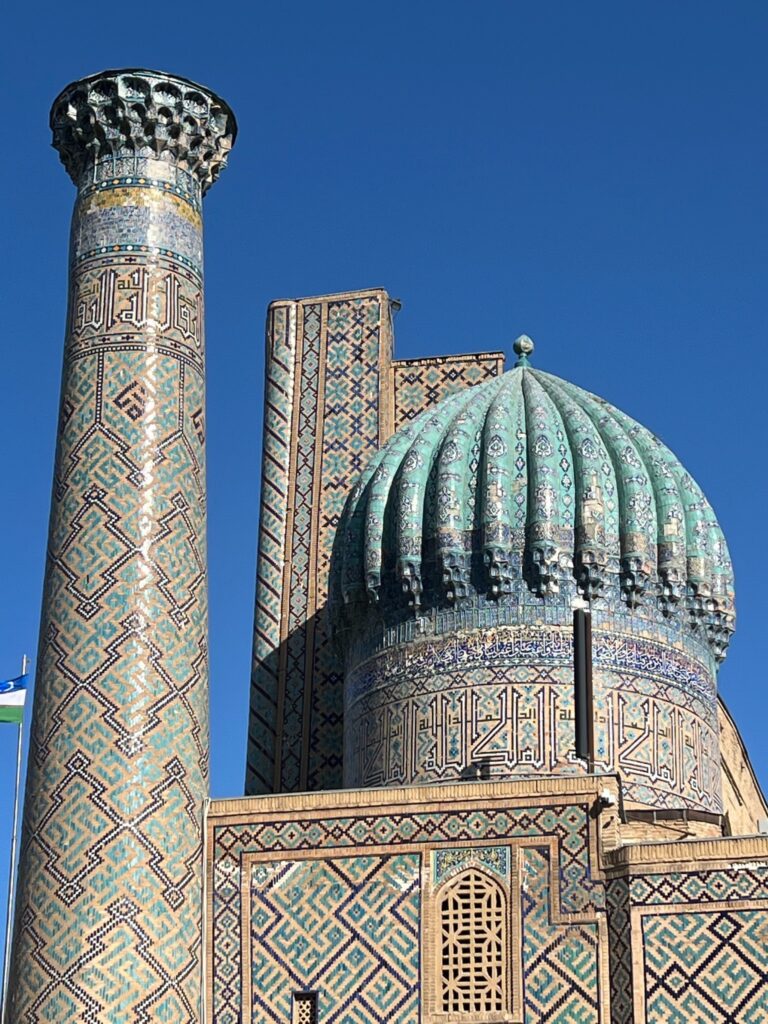
Look closely at the towers and one can see their lean. That is because the Registan, or “sandy place,” is built on sandy soil. It is thought that no earthquake faults run under Samarqand but as a Californian, I doubt that. It usually is just a matter of time. Fortunately, there is evidence of fortifications of foundations. Holes can be seen in the tile facades which were drilled to allow for contraction and expansion in the extreme heat and cold.
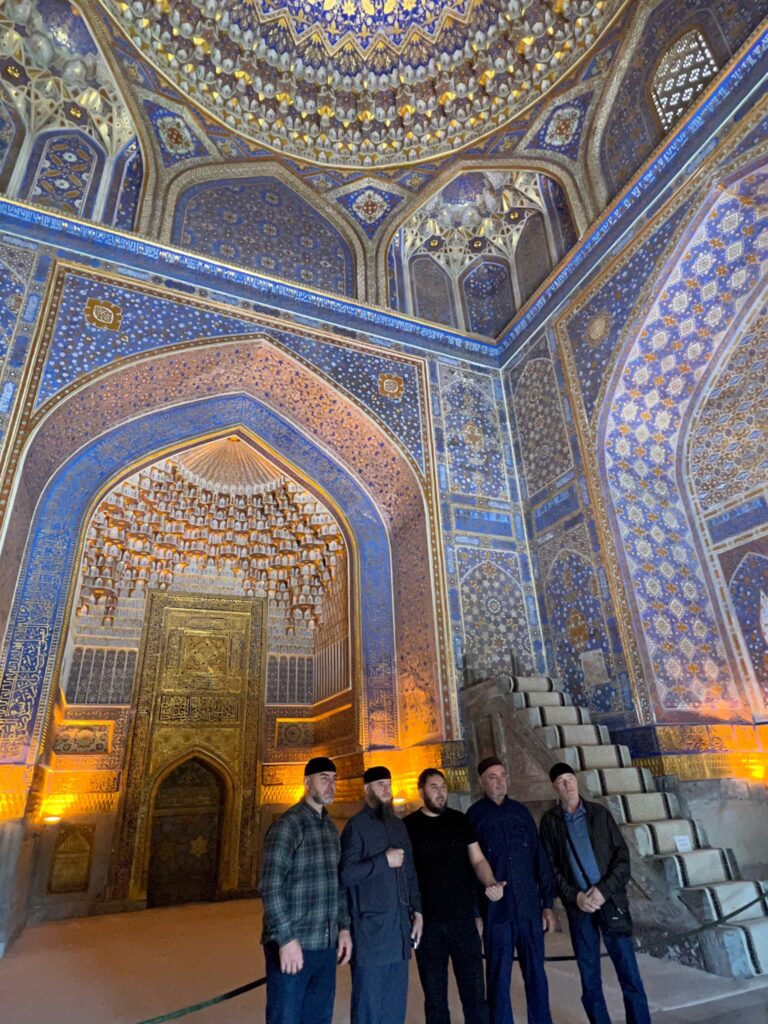
All the madrassas are inactive. Once the primary source of education for men to age 19 (some girls were allowed but instead of science and math got cooking and sewing), these educational centers were closed by the Soviets. In a way, this was a progressive movement as before the Russians less than 10% could read and write, after the Soviets made education free and closed the Madrassas, literacy reached 99%.
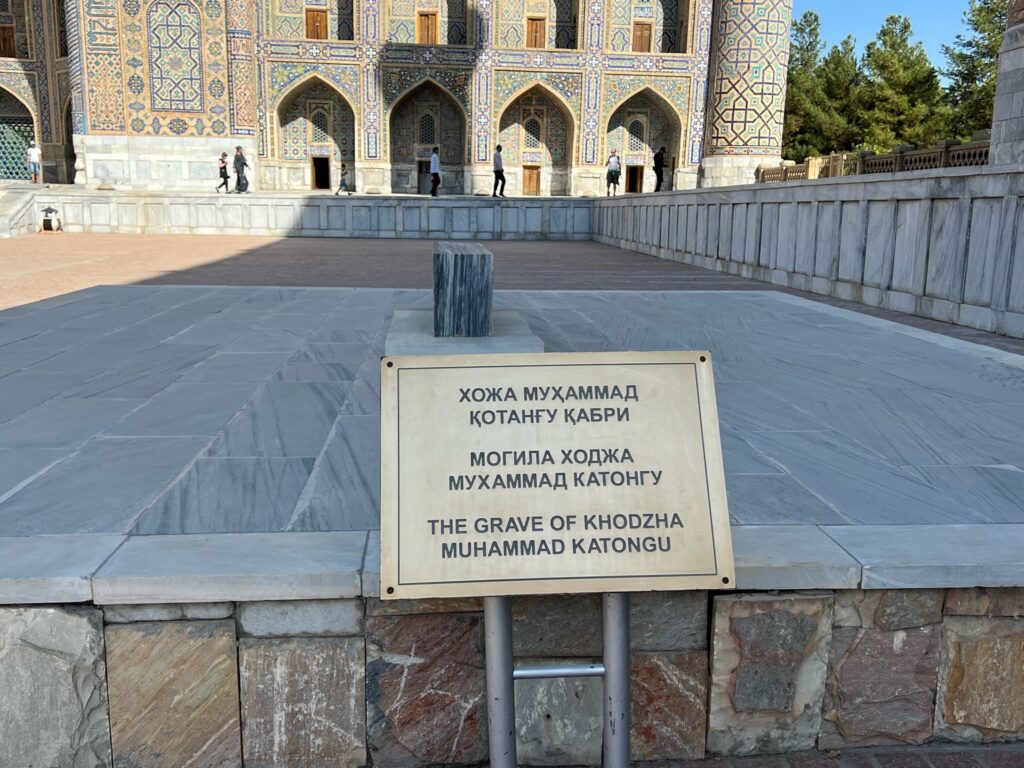
An interesting story told by our guide involves the only tomb in the square. Uzbeks love meat. While the construction continued, a rich butcher visited daily and tried to buy his way into the complex. This was refused. However, wise man that he was, the butcher instead offered to supply workers and architects with meat. For 17 years he provided meat. The honored butcher’s tomb can be seen at the foot of the Sher-Dor Madrassa.
Within the extensive gardens are the Chorsu Trading Dome, an ancient trading center on the Silk Road, and the Islam Karimov Memorial Statue. Karimov was the first president of Uzbekistan in 1990 until his death in 2016. His statue strikes me as a bit ironic but evidently Uzbeks adore their late “ruthless” dictator and even named Tashkent’s international airport in his honor.
I’ve written previously about Temur and his descendant’s contributions to the art, architecture and sciences of Central Asia. Temur was a military genius and a leader in the arts and sciences. He was extremely intelligent and intuitive. He developed a loyal and dedicated following both on and off the battle field. Probably one of the wisest sayings accredited to Timur is “veritas salus” or “truth is safety.”

We visit the Mausoleum Gur-e-Amir or Tomb of the King. As a forerunner in mausoleum architecture, this beautiful building with aquamarine dome contains the tombs of Temur, two of his sons, and his grandsons Ulugh Beg and Muhammad Timurid Sultan (the first to be buried here). Temur’s beloved teacher Baraka is also honored here. Good!
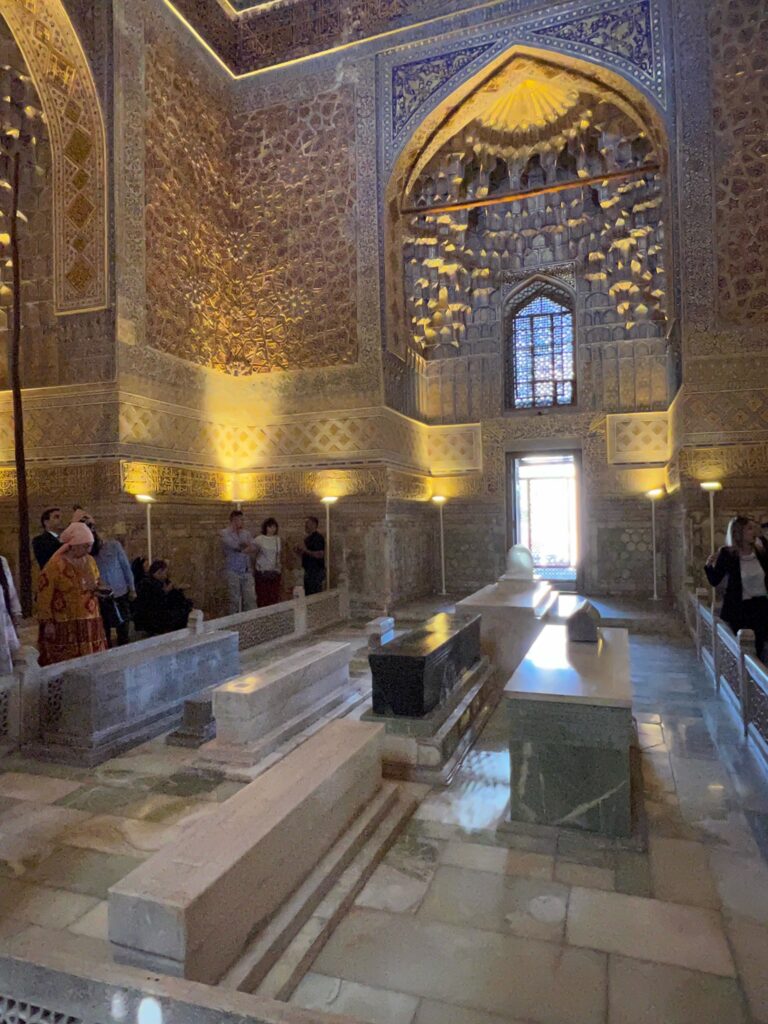
The Mausoleum Gur-e-Amir is simply constructed of carved bricks with colorful blue and white mosaics. The best part of the exterior is the unique azure ribbed dome. Inside, the color of gold is immediately noted. Surrounded by gold-colored walls and tile, walls decorated with stone slabs and decorative niches, it is truly an impressive tomb. In its center are the sarcophagi of the family. Paintings are usually not seen. Temur’s tomb is marked by a block of dark green jade.
This Mausoleum was originally built for Temur’s favorite grandson who died in battle at the age of 19. It ultimately became the burial location for Temur who died in Kazakhstan of pneumonia at the age of 69. It was winter and his soldiers couldn’t get him home so Temur was buried next to favorite grandson. At the height of Temur’s conquests, his empire encompassed 27 countries from Constantinople to Dehli.
Though Temur’s relationships with European kings and rulers, such as Spain where he regarded Henry III of Castile as “his very own son” and respected Charles VI of France, many of Temur’s other conquered cities, like Baghdad, Damascus and Delhi did not fair as well. Cities were sacked and destroyed and local populations killed. While Central Asians generally honor Temur, and he is a national hero in Uzbekistan, the feeling may not be mutual outside this Central Asia region. It is estimated that his conquests were responsible for the deaths of over 17 million people, about 5% of the world’s population at that time.
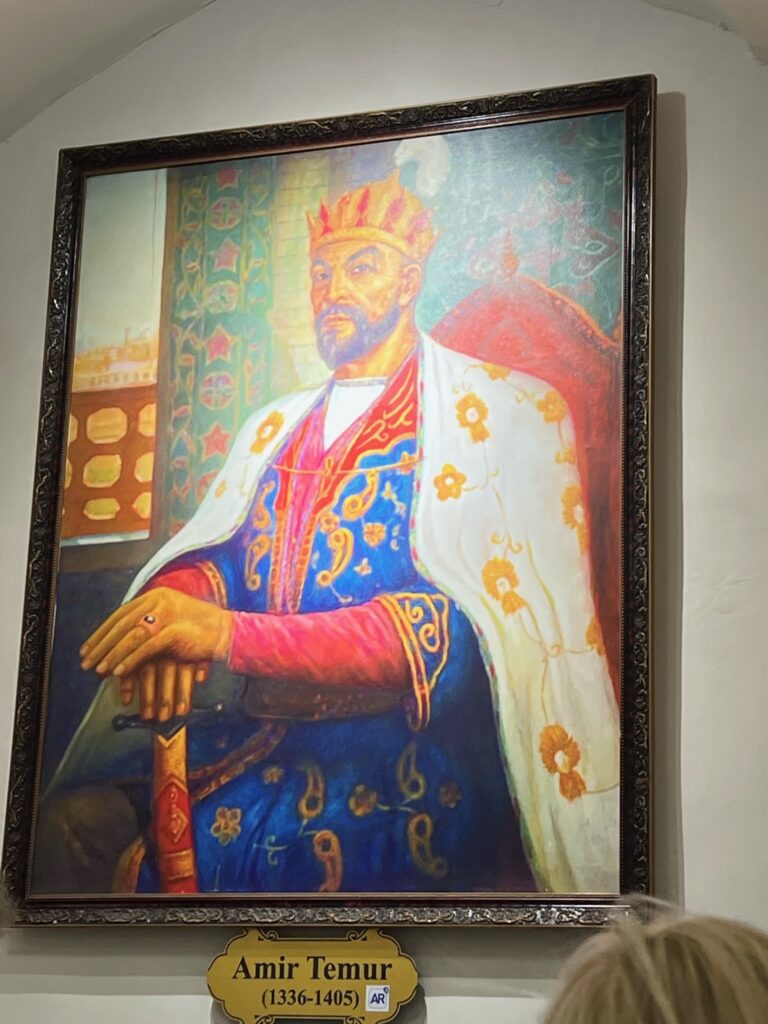
Another note, a bronze sculpture of Temur, done by Soviet anthropologist Gerasimov, is pretty factual as it was taken from the skull of Temur when his tomb was opened in 1941 by Gerasimov. He described the great leader as tall at 5’8”, lame, and with a withered right arm due to injuries. (Lane meant limp or lame and thus how the name Tamerlane was born, Limping Temur.) His reconstruction of the facial characteristics showed Mongoloid features. Allegedly, opening the tomb unleashed a curse. Temur was re-interred with full Islamic ritual in 1942.
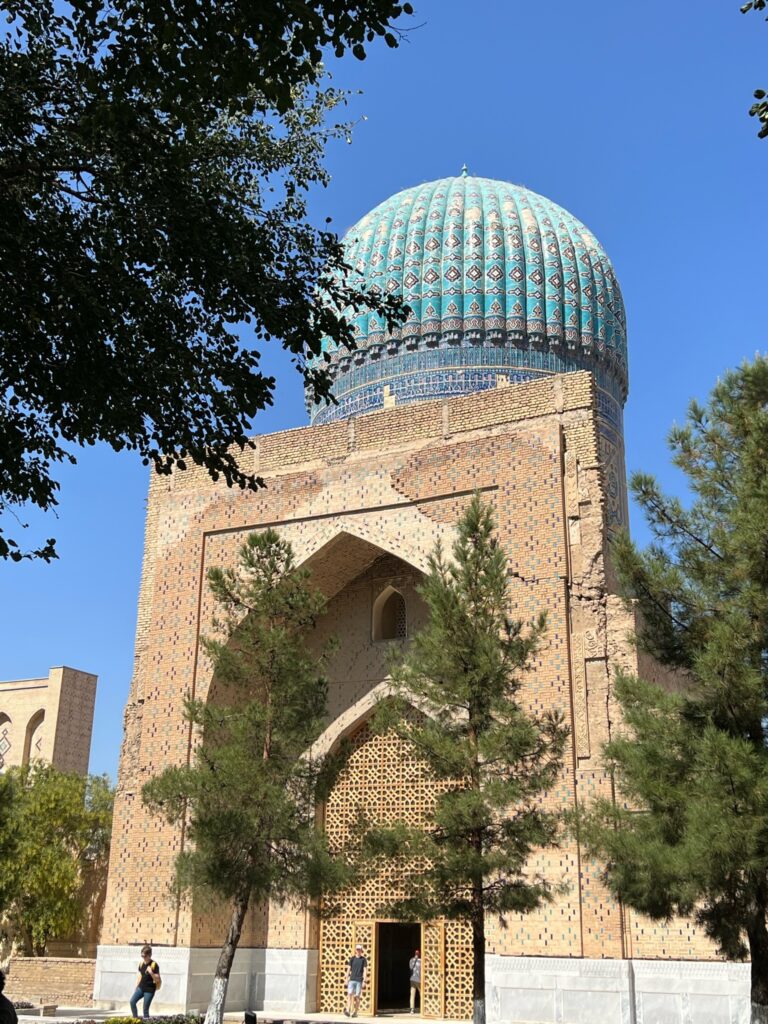
Our next visit is to the tomb that sexual harassment built. The story goes that Bibi Khanum (Temur’s wife) wanted to surprise her husband with a fancy mosque and mausoleum upon his return. Personally, seems a strange gift to give your “beloved husband” but maybe flowers were inappropriate. Anyway, the builder never seemed to be making progress to meet the completion date. Finally, when Bibi asked why it was taking so long, the builder replied that he wanted “a hug and kiss” from Bibi and the deadline would be met. This was a very risky demand considering the reputation of Bibi’s hubby. Eventually she gave in and gave the “fatal kiss” to speed along the building. When Temur returned, he was furious, not about the kiss, but that the construction was so shoddy. He refused to ever use the place.
Bibi Khanum Mosque and Mausoleum was built in the early 15th century and has seen its better days. Temur had ordered changes but the structural integrity was compromised and in the late 16th century, restorations and improvements halted altogether. Earthquakes, weather and deterioration have taken their toll. The minarets of the complex are restored. The fluted domes of the Mosque, blue and white tiles, carvings and designs are exceptional.
The sites of Samarqand just keep getting better. A little further from city center is the Shah-i-Zinda complex (The Living King). The expansive area consists of various brightly decorated tombs and mausoleums, the Tuman-Aka Mosque, and a nearby simple Muslim Cemetery for those who did not warrant a large tomb. The ensemble of structures are connected by arched narrow passages (chartak). The detail, color and carving is wonderful. Some tombs, like those of Temur’s sister, are quite elaborate; others have plain plaster interiors. The tomb complex was begun in the 11th century and expanded over 8 centuries and includes 20 buildings. Among its distinguished burials is Islam Karimov, the first President of Uzbekistan.
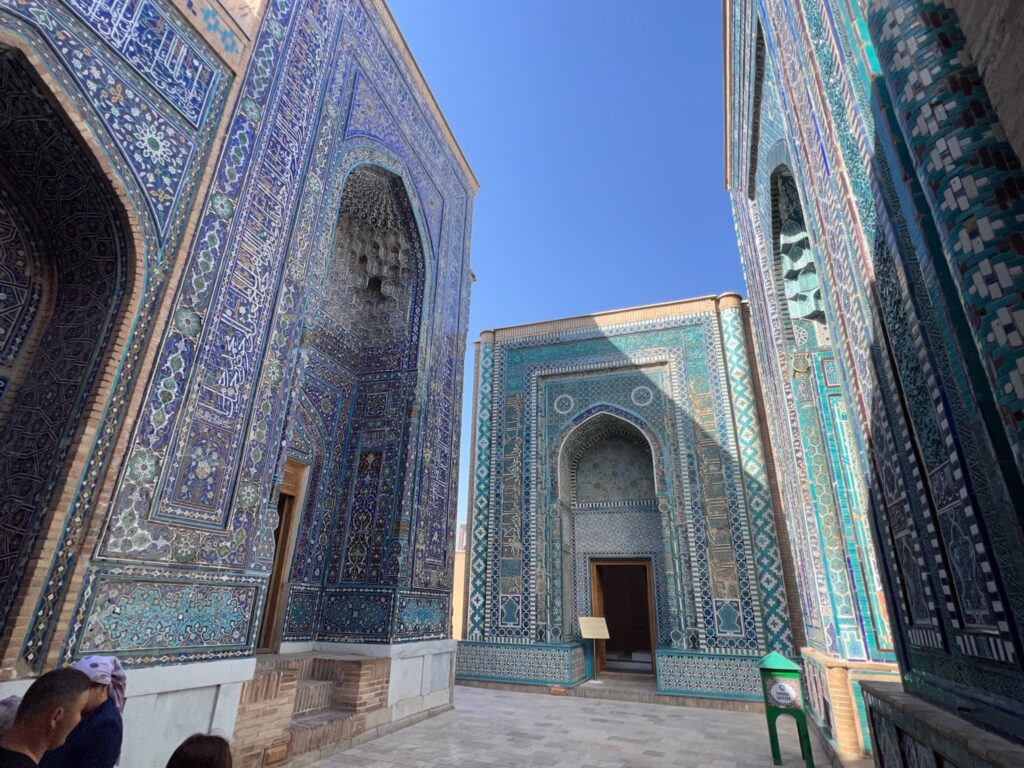
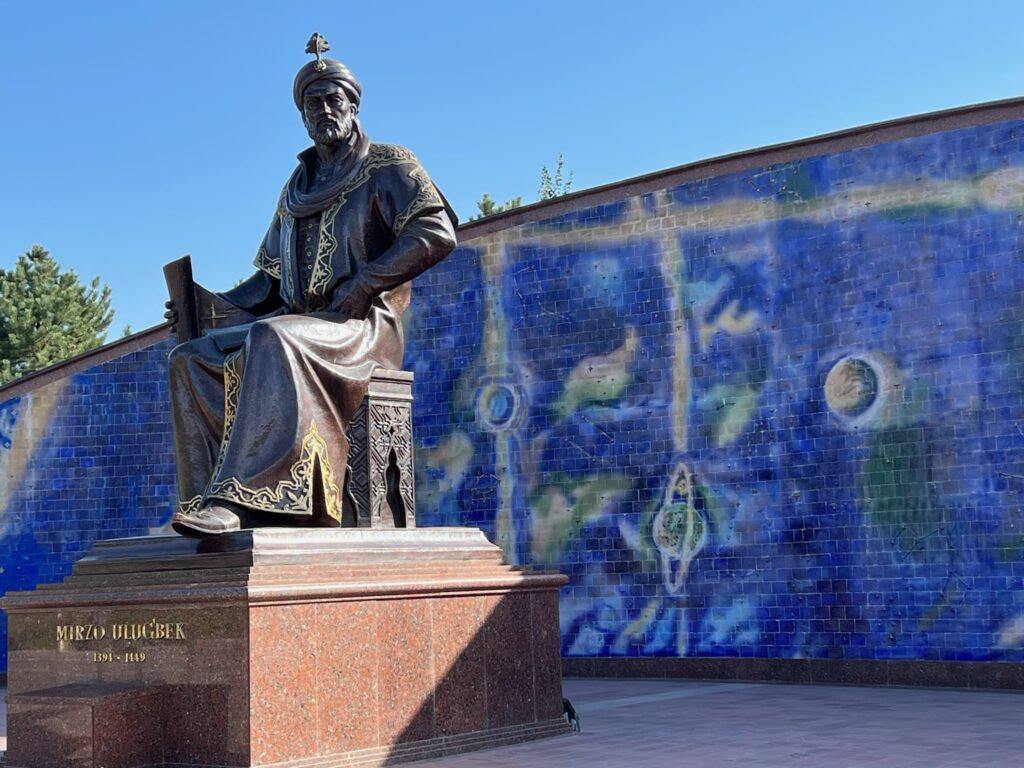
The Ulugh Beg Observatory was built by Temur’s grandson, astronomer Ulugh Beg in the 1420s. It is considered to have been the finest observatory in Central Asia. Here, many mathematical and astronomical theories were discovered and important astronomers trained. There is some confusion as to when the observatory was actually built but it is mentioned in written sources as early as 830. Much of the original grandeur is gone but the observatory is no less impressive for its place in history and Ulugh Beg’s achievements. Beg was able to calculate the accurate length of a year within less than a minute!
The Silk Paper Center has on display craftsmen who make silk paper from the mulberry tree. The center demonstrates and recreates what was ancient Samarqand paper-making along the Silk Road. I never much cared for the mulberry trees in my yard, but for silk making it is vital. Silk worms love them. But also, by boiling its bark (love the woody smell), pulling apart the strands and creating a mash, mixing this thick clay-like substance with water, and dipping screens into the mash one creates thin sheets of silk paper. Drying and a little smoothing completes the process.
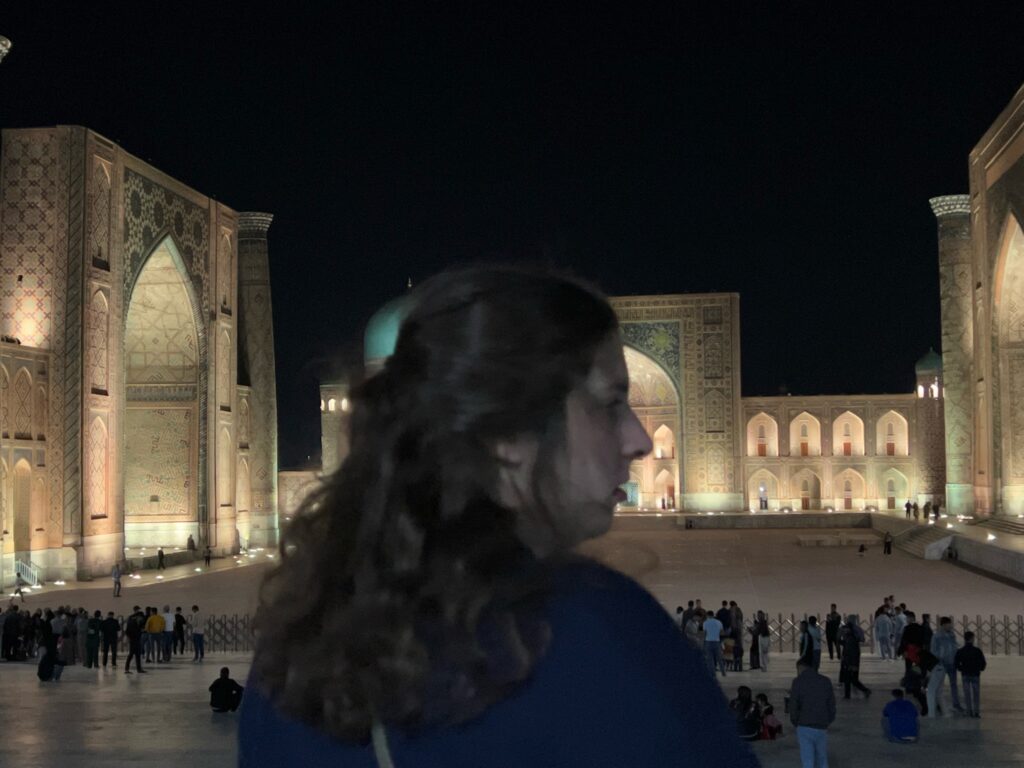
Our dinner is replete with dancers and ethic music while delivering our meat dish. Uzbeks really love meat! It is a cool evening and we stop for evening photos at Temur’s tomb and the wonderfully lit Registan. Just before midnight, fireworks light the sky, not sure why. Sadly, we must leave in the morning. I read that Samarqand was named as a UNESCO World Heritage Site in 2001. I wonder what took them so long.
0 Comments